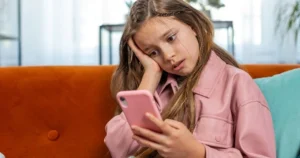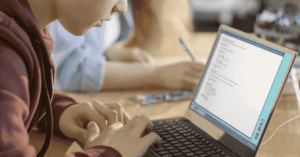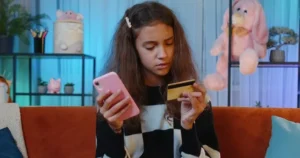Adolescence is a mini-series on Netflix released in March 2025 that follows 13-year-old Jamie who is accused of murdering his classmate. With themes around misogyny, online hate and social media, many parents are concerned about their child going online.
With so much conflicting opinions online, we’ve asked our expert panel to share their insights. See what advice they have to help parents and carers cut through the noise.
In this article
- What do parents and carers need to know about Adolescence?
- Should parents watch Adolescence?
- What are some key messages for parents to take from the series?
- What role do tech platforms play in tackling these issues?
- Supporting resources for parents and carers
What do parents and carers need to know about Adolescence?
There has been a lot of discussion about the programme over the past few weeks and, if nothing else, it has certainly got people talking about what children and young people are doing online.
Adolescence brings the incel community into sharp focus and for many in society, this is an area that they are unfamiliar with and shocked by.
Clearing up misconceptions
Some of the media coverage has spoken of the importance of parents understanding the secret signs and symbols used online. However, experts have suggested that in reality, whilst young people do use emojis, they are not something that are commonly used in incel communities.
There is also a lot of commentary stating that Jamie’s actions in the programme were all as a result of content and contact online. Whilst the online experiences clearly played a part there are other factors to consider, such as the influence of other people in his life including his dad and teachers at his school.
It is always easy to blame technology and the online world, and there are issues here that need to be addressed, but we also have to consider what other stakeholders and society as a whole need to do. There were plenty of warning signs, but they were seemingly missed by the adults around Jamie. For example, his mum mentions that he was always upstairs in his room, but she didn’t intervene and felt that it was the way that young people are nowadays.
If young people are feeling alone, isolated and vulnerable, they are likely to spend more time online and can find what they believe to be solutions. But they can also be exposed to narratives that can normalise violence; they can be subjected to peer pressure that will encourage them to make inappropriate comments to women and girls in order to ‘fit in’ as well. However, there are also other things that adults around them can do to engage with them and remind them that they are valued.
Adolescence has sparked vital conversations about misogyny, physical violence, abuse, social media and emotional harm. Many parents will also have received correspondence from their children’s schools, highlighting the themes and sharing guidance on online misogyny and the use of emojis.
While we welcome the focus this has given on the needs of young people, as a trauma-informed charity that works with families impacted by domestic abuse, it is important to remember that 1 in 5 children experience domestic abuse by the time they are 18 years old. This impacts how they see themselves, and those around them.
Should parents watch Adolescence?
I believe Adolescence is a show that parents can watch with their teens, but it’s not meant for classrooms. It’s a powerful drama with heavy themes. Before you watch the series together, first assess whether your child is mature enough to handle the content. Not every child is ready for topics like toxic masculinity, violence or negative school portrayals. Use your judgement to decide if this series is right for your family at this time.
If you believe it’s important for your teen to watch the series, remember to think about the following.
Before watching, consider whether your child is prepared for heavy themes. If you’re unsure, it might be better to wait until they’re more ready to engage with the material.
Watch the show with your teen. This way you can help guide the conversation and explain ideas as they come up.
While watching, prompt discussions with questions like:
- What do you think is missing in the show?
- Is there a perspective that isn’t shown?
- Does the story reflect your own online experience?
- Why wasn’t Katie’s (the victim’s) side of the story given more focus?
Use the show as a chance to discuss how media shapes ideas and influences behavior. Ask your child, for example, what qualities a good influencer should have or who they think influences them the most online.
What are some key messages for parents to take from the series?
At a time when children’s access to social media and smartphones is under debate, some have cited Adolescence as further evidence that the online space is too harmful, too risky to let children and young people go near until they reach a certain age. However, as always, balance and a measured response is needed and we all have a role to play.
As parents, we need to take an interest in what our children are doing when they are online – but in the words of the Chief Medical Officer, we shouldn’t be too intrusive or judgmental. Just because we don’t understand the attraction of a game they play or a social media platform they use, that doesn’t mean it is all a waste of time. In fact, research shows that there are plenty of positives for young people when they go online.
More needs to be done to challenge the current narratives that we see where powerful individuals can behave in reprehensible ways seemingly with little or no consequence. We need to revisit the values and morals that we think are important in our society and not be afraid to push back against some of the toxic rhetoric that seems to dominate both on and offline.
We need to use the opportunity presented by Adolescence to start those conversations and encourage a more open dialogue about the positives and the challenges of life online.
We know teenagers are vulnerable to relationship abuse (and if they are 16 or over this can be categorised as domestic abuse). However, it doesn’t happen in an online vacuum.
Yes, the online world can influence behaviour – both for children and adults. Yes, there needs to be more protections online and action to educate young people to keep them safe. But this must go hand in hand with our work as parents and carers to provide safe, stable and loving homes.
Don’t believe everything you read or hear. The show is not a documentary.
Explore the online world with your child; this does not mean you talk about ‘the’ online world as they do not see it in this way. Ask them what their views are about relationships (which include friendships) and asking them who they listen to on podcasts, YouTube and other streaming sites, as well as social media (it’s very varied as to how young people get their overall information about the world). And of course, most importantly, listen to their opinions. They do not have to share the same ones as you, and exploring how they got these views is the most interesting conversation you are likely to have with them!
To learn more about how to parent in a world of technology you can pre-order my new book Tech Smart Parenting here.
What role do tech platforms play in tackling these issues?
The tech platforms need to do more, particularly when it comes to reducing the amplification of misogynistic, male supremacist and other harmful content through the algorithms and recommendation systems that they use. Some content which does not necessarily contravene community guidelines (or terms and conditions) can still be very harmful for younger users.
Whilst many platforms now offer a safer experience for users that are under 18, many of these safeguards rely on the platform actually knowing that they are dealing with a child. This is great if everyone is honest about their age when they sign up, but of course this is not always the case.










